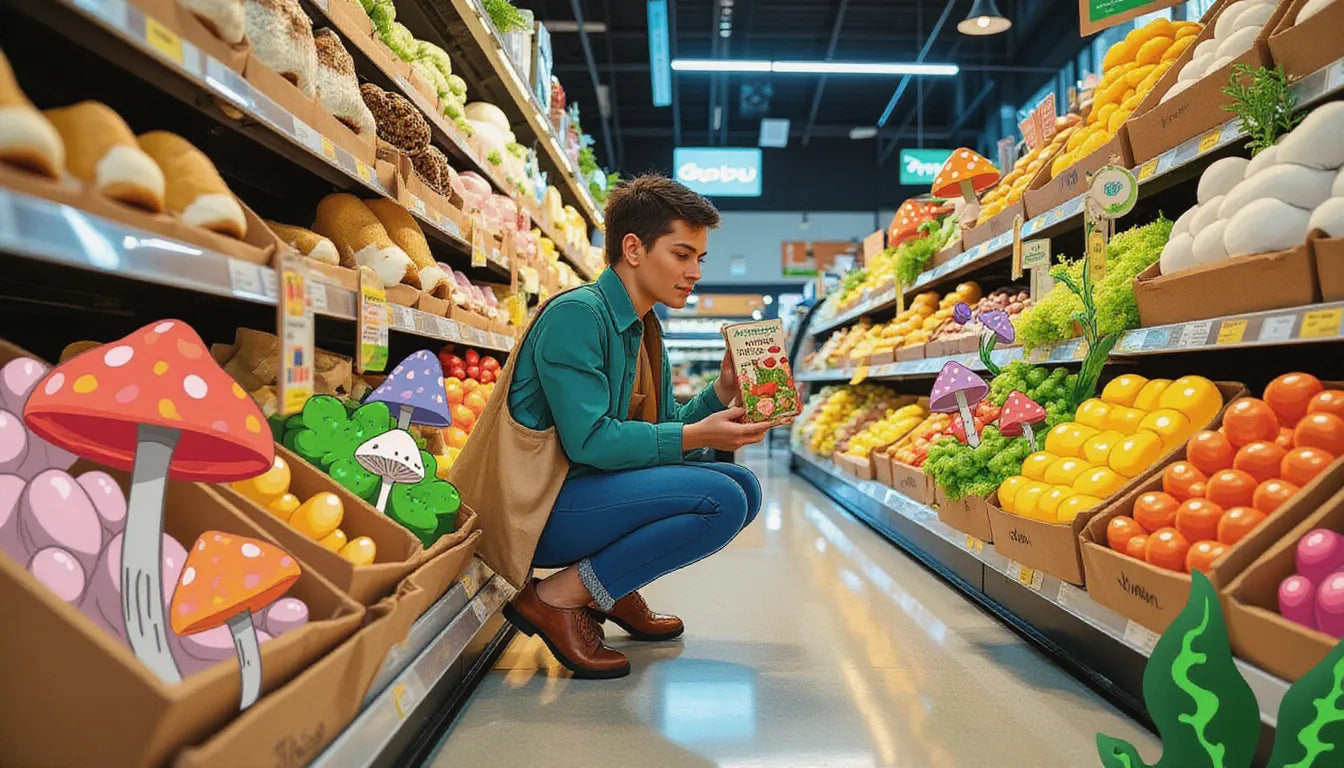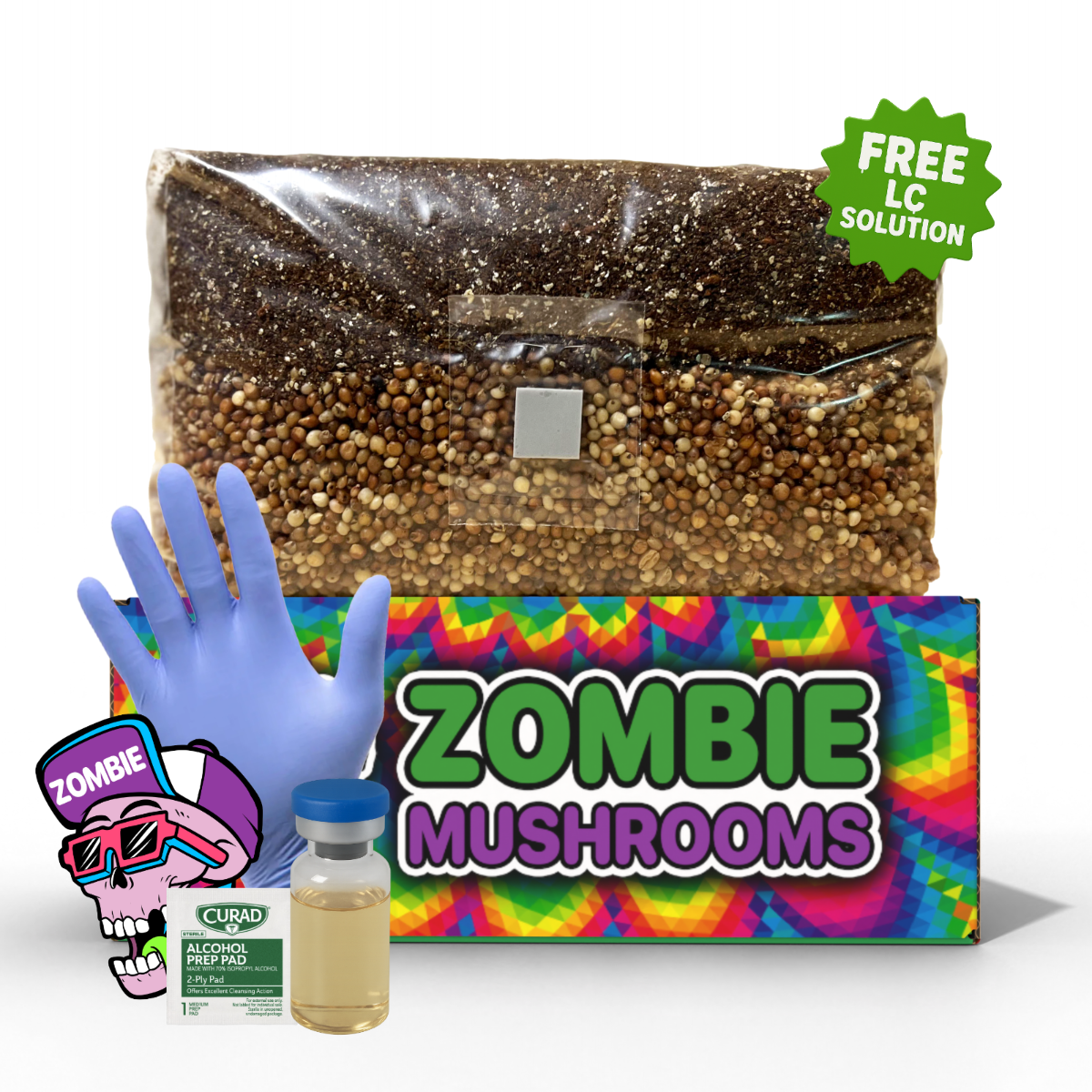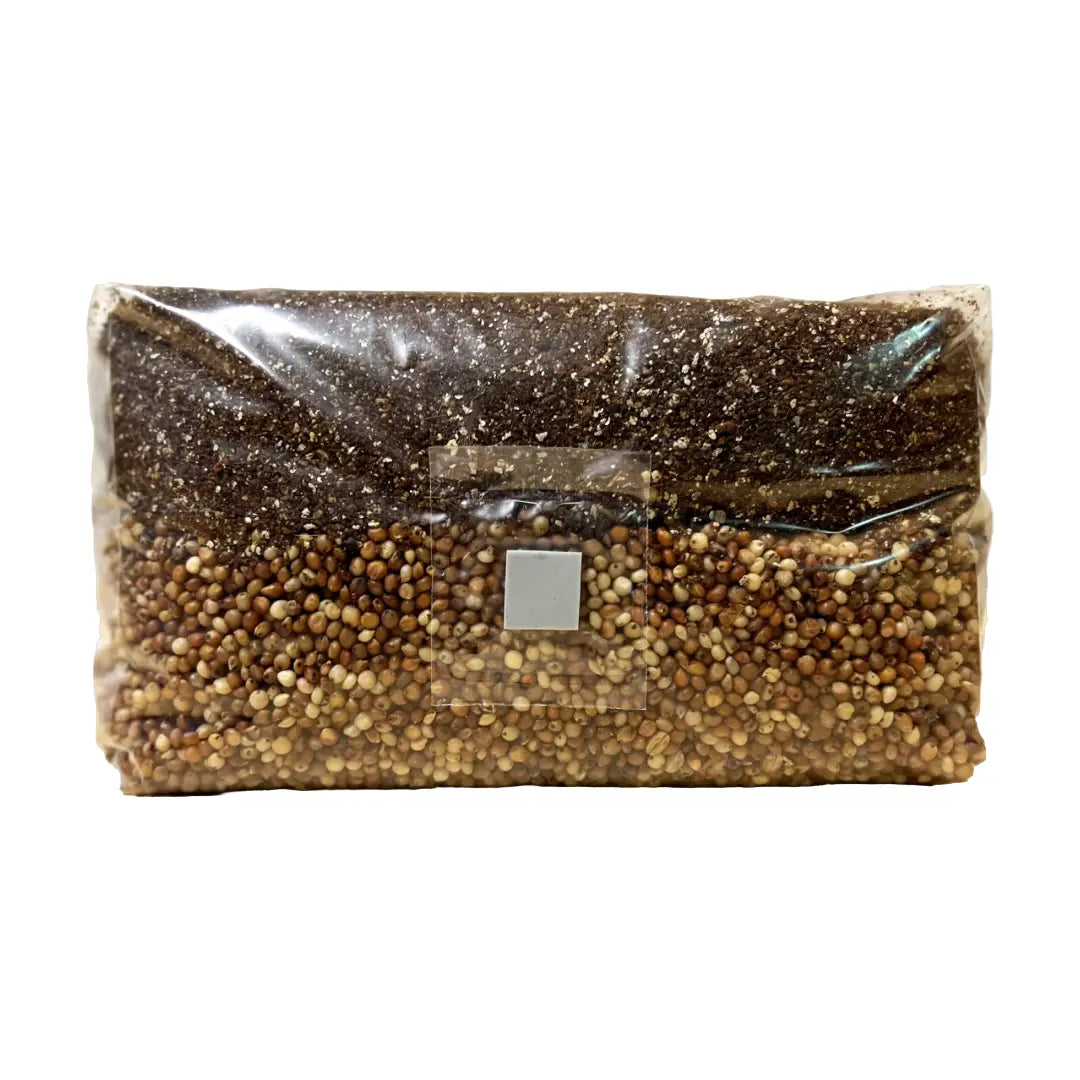⬇️ Prefer to listen instead? ⬇️
- Mushrooms like maitake and shiitake may enhance immune function (U.S. Department of Agriculture, n.d.).
- Rich in B-vitamins, selenium, and antioxidants like ergothioneine, mushrooms support metabolic and cellular health (Feeney et al., 2017).
- Choosing loose mushrooms over packaged ones helps ensure better freshness and quality.
- Dry sautéing mushrooms boosts flavor while preserving nutritional compounds (Dubost et al., 2006).
- Growing mushrooms at home offers peak freshness and educational immersion into fungal cultivation.
Scouring the forest for chanterelles is exciting, but most people can't easily get to wild places. Luckily, grocery store mushrooms are a tasty, safe choice. They have good health benefits and you can cook them in many ways. With the right tips for finding mushrooms in the store, you can pick the best fresh ones. And for those who want to go a step further, home cultivation kits and substrates like coco coir bricks make it possible to experience mushrooms beyond the produce aisle.

The Most Common Grocery Store Mushrooms – And Why They’re Worth Your Cart
Nearly every supermarket has a selection of mushrooms you can use for different dishes. The most common ones—white button, cremini, and portobello—are all types of the same mushroom: Agaricus bisporus. Even though they are related, these mushrooms look different, taste different, and work best for different dishes.
-
White button mushrooms are the youngest and taste the mildest. They have a mild taste. It's best to use them raw in salads or cooked lightly to eat with eggs, pasta, and pizza. They are soft and small, which makes them good for many everyday meals.
-
Cremini mushrooms (sometimes called baby bella) are older than white buttons. They feel firmer and have a stronger earthy taste. Creminis are good in hearty stews, braises, and winter soups.
-
Portobello mushrooms are just older creminis. They are dense and meaty. This makes them a great choice for vegetarian burgers, grilling, or stuffing with tasty things like cheeses and herbs.

Spotlight on Specialty Varieties
In addition to the supermarket staples, keep an eye out for these gourmet contenders:
- Shiitake: With an intense, umami-rich flavor, shiitakes are ideal in stir-fries or broths. Their caps become slightly crispy when roasted or sautéed.
- Oyster mushrooms: Delicate and fan-shaped, these cook quickly and absorb flavors well, making them perfect for sautés or tempura.
- Maitake (Hen of the Woods): Frilly and woodsy with a nutty flavor, maitake mushrooms are often roasted or used in hearty dishes like risotto.
- Enoki: These tiny, long-stemmed mushrooms add crunch and a mild taste—perfect for noodle bowls or miso soup.
- Lion’s Mane: With a crab-like texture and subtle sweetness, lion’s mane can be grilled or pan-fried as a seafood alternative.
Choosing from this bigger selection doesn't just make your dishes taste more interesting. It can also give you more health benefits. Plus, it can make your home cooking seem more special.

How to Judge Mushroom Freshness Like a Pro Forager
Wild mushroom hunters check their finds carefully. You need to look closely when picking fresh mushrooms from the store shelves too. Here's how to check grocery store mushrooms like an experienced forager:
- Firmness: Gently squeeze each mushroom. They should feel resilient and slightly springy, not mushy or hollow.
- Texture: A fresh mushroom cap feels dry and smooth. Avoid those with slimy or sticky exteriors.
- Color: If the color is even without wilting edges or dark spots, it means they were recently picked.
- Gills and cap condition: Open-capped varieties should have dry, dark gills that aren't overly moist or decomposing.
- Scent: A fresh mushroom smells pleasantly earthy. Smells like ammonia or sourness mean they are going bad.
Also, don't buy packaged mushrooms that have a lot of water inside. Water in sealed containers makes them mushy and spoils them quickly. Try to buy from stores that sell loose mushrooms. Or at least, look for mushrooms in containers with holes so you can check them.

Mushroom Hunting Tips for the Grocery Store Aisle
Finding mushrooms in the supermarket is a bit of an art, not just a quick trip. Use these tips for mushroom hunting to get better at picking them in the produce section:
- Shop early: Stores often restock shelves in the morning, particularly on days after shipments arrive (typically Tuesday and Thursday for many chains).
- Go loose: Mushrooms sold loose let you touch and look at them. This way, you can pick the freshest ones yourself.
- Use your nose and eyes: Smell and inspect before placing in your cart—much like wild foraging, it's about choosing the best from what's available.
- Try specialty grocers: Asian markets, health food stores, and farmer’s markets are unbeatable sources for more exotic, less mass-distributed mushroom varieties.
- Talk to staff: Talk to the produce manager at your grocery store. They can tell you when new mushrooms come in. They might even special order kinds if you ask.
Think of your local grocery store as your terrain—each section with its microclimate of freshness and quality.

When to Hunt: Best Days to Mushroom-Shop
Timing is crucial in the supermarket mushroom hunt. While different stores vary in their restocking schedules, most receive produce deliveries a few times per week.
- Best days: Tuesday and Thursday mornings are often peak times to find newly delivered mushrooms.
- Avoid weekends: By Saturday or Sunday, shelves are often already picked through. Mushrooms may have been sitting out too long in not ideal humidity or temperature.
- Early bird advantage: Getting there soon after the store opens gives you a better chance of getting the best mushrooms before other shoppers handle them.
Pro tip: Make a habit of shopping for mushrooms on the best delivery days. You'll have much better luck finding good ones.

What to Hunt For: Mushrooms That Deliver More Than Flavor
Fresh mushrooms don't just make dishes better. They also give you many nutritional benefits. Let's look at why they should be a regular part of your diet:
- B-Vitamins: Mushrooms are high in riboflavin, niacin, and pantothenic acid. These nutrients help convert food into energy and support nervous system function.
- Selenium: A powerful antioxidant mineral, selenium supports immune health and assists with DNA repair.
- Ergothioneine: This antioxidant compound found primarily in mushrooms helps reduce oxidative stress and may support healthy aging (Feeney et al., 2017).
- Fiber content: With dietary fiber, mushrooms promote digestive health and satiety.
- Meat alternative: Varieties like portobello, oyster, and lion’s mane offer satisfying textures for people reducing meat consumption.
Researchers are also looking into if mushrooms like shiitake and maitake can affect how the immune system works (U.S. Department of Agriculture, n.d.). Mushrooms are foods that do more than just taste good—they are delicious and have health benefits.

How to Store Your Mushroom Haul Like a Mycophile
Once you've bought some really good grocery store mushrooms, storing them is the next important step. Mushrooms go bad very quickly. Storing them wrong can make them lose flavor and nutritional value.
Storage Do’s:
- Paper over plastic: Use a brown paper bag, which absorbs moisture and allows mushrooms to breathe in your fridge.
- Crisper drawer: Store in the crisper, as it offers better humidity control.
- Fridge temperature: Maintain between 34°F and 38°F (1°C–3°C) to keep mushrooms crisp.
- Use quickly: Aim to eat within 5–7 days, while mushrooms are still firm and fragrant.
- Long-term preservation: Mushrooms can be sliced and dehydrated for shelf-stable storage or sautéed and frozen in small portions for easy meal-ready additions.
Storage Don’ts:
- No sealed containers: Don't use airtight plastic containers or bags. They trap water and make them spoil faster.
- No washing before storage: Wash mushrooms right before you use them. Getting them wet before you store them makes them go bad sooner.
Treat your mushrooms with care—as a forager would—and they’ll give you their best in return.

Cooking Techniques to Get the Most Out of Everyday Grocery Store Mushrooms
Getting the most out of mushrooms for cooking means knowing how they cook with heat and oil. Here’s how to get the best flavor:
- Dry sautéing: Place sliced mushrooms in a dry pan over medium-high heat. Let their internal moisture evaporate before adding oil or seasoning. This intensifies texture and taste.
- Roasting: Toss mushrooms in olive oil, salt, pepper, and herbs, then roast at 400°F until caramelized. Roasting brings out their natural umami and crisps their edges.
- Grilling: Grill whole portobellos or thick-cut lion’s mane as meat alternatives. Marinate in balsamic, garlic, or soy sauce to broaden their flavor.
- Sautéing with aromatics: Combine mushrooms with garlic, onions, and thyme for a dreamy side dish or base for sauces and risottos.
- Stir-fry: Thin-sliced oyster or shiitake mushrooms cook quickly and complement savory sauces in Asian-inspired meals.
Importantly, studies show that the antioxidant content in mushrooms increases with certain cooking methods—especially sautéing and grilling (Dubost et al., 2006).

Mushrooms Are Worth the Hype: Nutrient-Packed, Low-Calorie, Flavor-Rich
Why do dietitians and gourmet chefs all like mushrooms? Because they have a great mix of nutrition, are easy to use in many dishes, and are good for the environment.
- Low calories, high satisfaction: Mushrooms are over 90% water and remarkably filling, making them a go-to for calorie-conscious eaters.
- Natural vitamin D: When grown under UV light or sunlight, mushrooms are one of the few plant-based sources of vitamin D—an essential nutrient for bone health and immunity (Feeney et al., 2017).
- Flavor boosters: Mushrooms bring savory, umami notes to dishes without adding fat or sodium.
- Eco-friendly proteins: Compared to meat production, mushroom cultivation uses significantly less water and generates fewer emissions.
Including fresh mushrooms in your diet makes practical and planetary sense.

The Underrated Grocery Mushrooms You Might Be Walking Past
Some types of mushrooms are making home cooking much better in a quiet way. But you might walk right past them in the supermarket. Look for these less common choices that make a big difference:
- King trumpet (Royal oyster): Thick stems and robust texture ideal for slicing into steaks or medallions—especially great when seared or grilled.
- Beech mushrooms (Shimeji): Nutty and slightly crunchy, they keep their shape in heat and pair beautifully with seafood.
- Enoki mushrooms: Mild, crisp, and noodle-like, enoki go well with miso soup and ramen. Or they are a nice addition to cold noodle salads.
If these mushrooms aren’t available at your local grocery, check out Asian markets or natural co-ops. Better yet—ask the staff to consider stocking them.

Beyond the Aisles: Why Grow-Your-Own is the Ultimate Mushroom Hunt
If you love mushrooms and want to do more, growing them at home is a really impressive cooking project. With home grow kits from brands like Zombie Mushrooms, growing gourmet mushrooms is easy to do and rewarding.
Why Grow Your Own?
- Maximum freshness: Pick them just minutes before you cook them for flavor and texture you can't get any other way.
- Educational fun: Learn about mushroom biology, life cycles, and sustainable growing techniques.
- Variety control: Choose specific mushroom varieties that aren’t available in stores.
- Year-round yield: Indoor growing setups provide consistent harvests regardless of season.
Whether you just do it for fun or hope to grow food in the city, growing mushrooms can make your home feel like a mini fungal forest.

A Mushroom for Every Season: Seasonal Shopping Tips
Even though you can buy mushrooms all year, some types fit well with meals and menus for each season. Here’s how to shop based on the season:
- Spring: Seek out morels, one of the most prized wild mushrooms. Specialty stores sometimes carry farmed versions.
- Summer: Grilled portobello mushrooms are a standout at BBQs and cookouts—try marinated with herbs.
- Fall: Earthy, dense varieties like hen-of-the-woods and shiitake pair beautifully with roasted vegetables and warm grains.
- Winter: Add shiitake, cremini, and king oysters to stews and risottos for hearty, umami-rich meals.
Follow the flavors of the season to create meals with not just taste, but harmony.
Connect with Other Fungiphiles: The Mushroom Community
People who like mushrooms are a lively, varied group. If you want recipes, help identifying mushrooms, or growing advice, you can find a group no matter your skill level.
Where to Connect:
- Reddit forums like r/mycology and r/shroomID offer ID help and growing tips.
- Instagram: See #mushroomhunting, #mushroomrecipes, or follow @ZombieMushrooms for growing inspo and updates.
- Facebook groups: Search for mushroom cultivation or foraging groups for both beginners and pros.
Being part of the mycological world offers not just knowledge, but a sense of shared wonder.

Tips for Mushroom Enthusiasts Ready to Go Beyond the Grocery Store
Once you've mastered the grocery mushroom hunt, you may be ready to take it further. Here’s how:
- Try advanced cultivation: Incorporate agar plates, grain spawn, humidifiers, and grow tents for hands-on mushroom farming.
- Learn from mycologists: Take classes or watch tutorials to understand mushroom anatomy, cloning, and sterilization techniques.
- Experiment with medicinal mushrooms: Try growing varieties like reishi or turkey tail. Or learn about taking them as supplements—do it safely and with thought.
Diving deeper into the world of mushrooms opens up endless possibilities.
Your Weekly Mushroom Hunt – No Hiking Boots Required
You don't need forests or foraging skills to get into the world of mushrooms. People who like mushrooms today can find dozens of gourmet and good for your health varieties at their local grocery. Or even better, they can grow them at home. Armed with mushroom hunting tips, your fresh mushrooms can turn weeknight meals into interesting cooking projects.
Ready to become more of a mushroom lover? Check out Zombie Mushrooms grow kits and turn your countertop into a good place for mushrooms to grow—you won't need a compass.



